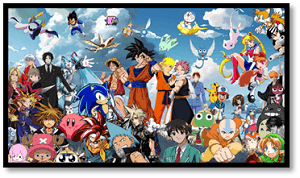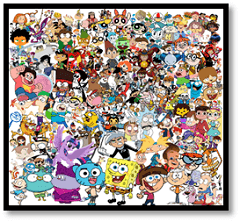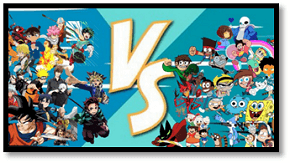Difference Between Anime and CartoonAnime
Hand-drawn and digitally created animation from Japan is known as Anime. Anime is a term used only to describe Japanese animation outside of Japan as well as in English. However, anime (a term derived out of an abbreviation of the English word animations) refers to all animation works, regardless of genre or origin, in Japan and in Japanese. Anime-influenced animation is a term used to describe animation created outside of Japan with elements of Japanese animation. The first Japanese commercial animations appeared in 1917. With the help of cartoonist Osamu Tezuka, a distinctive art form arose in the 1960s and flourished throughout the following decades, gaining a sizable domestic following. Anime is broadcast on television, sold directly to consumers' home media, and made available online. Aside from original works, anime frequently features translations of light novels, video games, or Japanese comics (manga). It is divided into a variety of genres that speak to both broad and specialized audiences. Anime is a multifaceted art form with unique production techniques that have evolved in reaction to new technologies. It mixes graphic design, character development, cinematography, and other creative and unique methods. In contrast to Western animation, anime productions typically places a greater emphasis on scene details and the use of "camera effects," including panning, zooming, and angle shots. Character proportions and characteristics can vary considerably, and a typical characteristic is the usage of big, expressive eyes. Different art techniques are employed. Over 430 production firms work in the anime industry, including well-known ones like Studio Ghibli, Ufotable, MAPPA, Kyoto Animation, Production IG, Sunrise, Bones, Wit Studio, CoMix Wave Films, and Toei Animation. With the rise of foreign programming that was dubbed and subtitled starting in the 1980s, the format has also experienced significant international success. Since the 2010s, its dissemination has increased through streaming services, and a wider population has begun to enjoy anime culture both in Japan and internationally. 60% of animated television programmes around the world as of 2016 were Japanese. Cartoons
Cartoons are a form of visual artwork that is usually created in an illogical or imperfectly realistic manner and frequently animated. Although the precise definition has changed throughout time, the present usage typically refers to either: a graphic or series of images meant for parody, exaggeration, or humour; or a motion picture technology that uses a series of images for its animation. A cartoonist is a term used to describe someone who makes cartoons, while an animator is a term used otherwise. The idea first appeared in the Middle Ages and was used to describe a preparatory drawing for a work of art, such as a painting, fresco, tapestry, or stained-glass window. Cartoons in newspapers and magazines came to be known as such in the nineteenth century after appearing in "Punch magazine" in 1843, which was ironic at the time. Later, it was also applied to comic strips and political cartoons. Early in the 20th century, as the medium developed, it started to be used to describe animated movies that looked like print cartoons. A cartoon in print media is a sketch or group of drawings with a typically humorous intent. This phrase's first appearance in print was in 1843 when "Punch magazine" used it to describe satirical caricatures, especially those by John Leech. The first of them mocked the elaborate historical fresco preparatory sketches in the newly constructed Palace of Westminster. The term "cartoon" eventually came to mean animation due to the visual resemblances between comic strips & early animated films. Today, the term "cartoon" can apply to both animated cartoons & gag cartoons. The term "cartoon" is most frequently used to describe children's television shows and short films that may include humanoid animals, superheroes, the exploits of young protagonists, or comparable topics. Animation refers to any form of graphical images shown in fast succession to create the illusion of movement. Toon, an abbreviation of a cartoon that refers to animated figures, became popular in the 1980s. The 1988 live-action/animated hybrid film "Who Framed Roger Rabbit", along with the 1990 animated television series Tiny Toon Adventures, helped to popularise this phrase. Difference between Anime and Cartoon
Next TopicDifference between
|
 For Videos Join Our Youtube Channel: Join Now
For Videos Join Our Youtube Channel: Join Now
Feedback
- Send your Feedback to [email protected]
Help Others, Please Share










